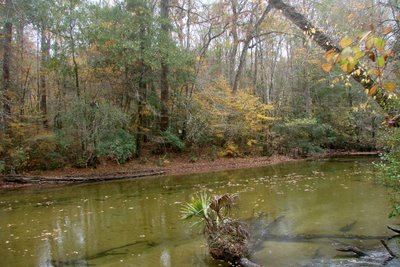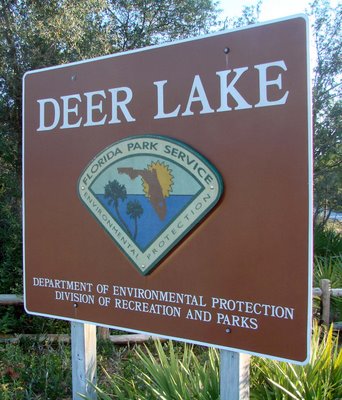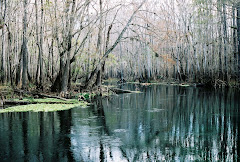Thursday, November 30, 2006
Fall color along Econfina Creek
Fall color comes relatively late to Florida, usually in mid to late November and early December. I set out today to view some of this seasonal splendor along the banks and bottomlands of Econfina Creek, which straddles the Washington-Bay County line in the panhandle of Florida. The most popular access point is about 8 miles east of the small crossroads community of Crystal Lake on Florida State Hwy. 20.
This little known gem is administered by the Northwest Florida Water Management District, and is a protected watershed for the Deer Point Lake Reservoir, which supplies Bay County with its largest amount of culinary water.
Econfina Creek is believed to be a Muskogean term meaning "natural bridge", because it may have flowed underground at one time through the highly porous limestone found in this part of the state. The Econfina is unique in that about 80% of its flow is fed by eleven natural springs. The clarity of the water is amazing and it is a popular destination for those wishing to canoe or kayak its crystal clear waters. This is easily one of my favorite natural wonders in all of Florida.
For more information about floating Econfina Creek you can call 850-722-9032.
Tuesday, November 28, 2006
Saint Joseph Peninsula State Park
 St. Joseph Peninsula State Park is located just south of Port St. Joe in Gulf County. It occupies the central section of an L-shaped peninsula that juts out from the mainland at San Blas Point. This barrier island is bordered by the Gulf of Mexico on the its western side and the sheltered waters of St. Joseph Bay to the east.
St. Joseph Peninsula State Park is located just south of Port St. Joe in Gulf County. It occupies the central section of an L-shaped peninsula that juts out from the mainland at San Blas Point. This barrier island is bordered by the Gulf of Mexico on the its western side and the sheltered waters of St. Joseph Bay to the east.Mainly visited for its ten-mile strand of white sand beaches and crystal blue waters it also is a well known haven for bird watchers, where 240 different species of birds have been recorded through years of careful observation and record keeping.
Other activities include hiking, biking, canoeing, kayaking and fishing. There are campgrounds as well as cabins for rent, with many nearby accomodations readily available. The beach is rated as one of the best in the United States by an expert who calls himself the Beach Doctor.
If you decide to make a visit I strongly reccomend that you bring along lots of insect repellent because the biting bugs can be vicious, especially flies and mosquitoes on the bay side of the park. We visited in early November and the bugs were pretty thick everywhere but on the Gulf shore.
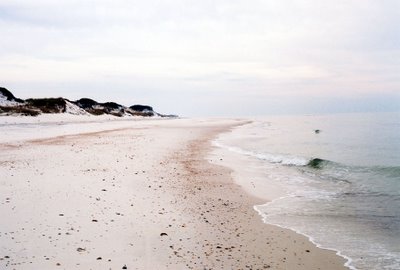
Miles of deserted beaches await the visitor.

The interior scrub forest is criss-crossed by hiking trails.

Tranquil scene on the bay side of the park.

Lush vegetation lines the main park road.

Scrub covered dunes abound.

The beachcombing is excellent.
For more information: http://www.floridastateparks.org/stjoseph/default.cfm
Friday, November 17, 2006
Deer Lake State Park
This very small park, located along the south coast of Walton County in Seagrove Beach, is a slice of pure Florida heaven. Sandwiched in between major resort developments and busy Highway 30A, this lovely and quiet preserve offers the visitor a multitude of natural wonders to experience within its eleven documented life zones. The park is named for the large coastal dune lake that is located within its boundaries but also has a gorgeous beach, a large area of crystal white sand dunes and a thick forested hammock of hardwood and pine.
Deer Lake is one of seventeen dune lakes located along the Gulf of Mexico in this vicinity that are extremely rare worldwide. For more information about these interesting and fragile lakes please refer to my earlier blog posting on Topsail Hill Preserve.
The forest here includes southern magnolia, scrub oak, long leaf pine and palmetto. Rare plants such as gulf coast lupine, spoonflower, pitcher plants, and Curtiss' sand grass form some of the largest populations found in Florida.
There are many species of resident or migratory birds and butterflies that utilize this fast disappearing mixed dune and coastal forest habitat, including the endangered least tern and loggerhead turtle. Other animals include bobcat, coyote, fox, raccoon, skunk, and a large assortment of reptiles and amphibians including alligators that inhabit Deer Lake. Park visitors can picnic, swim, and fish, but there is no camping as this is a day use area that closes at sundown.
I am very lucky, because I live right next door to this beautiful preserve and can visit it whenever I want. So by all means come on down and enjoy this perfect slice of the Florida panhandle. It is rarely crowded and always offers beauty, solitude and inspiration.
 Park woodland
Park woodland
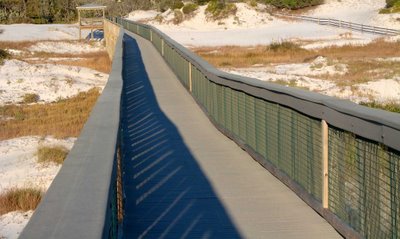
Walkway across the dunes

Tracks in the dunes

Deer Lake
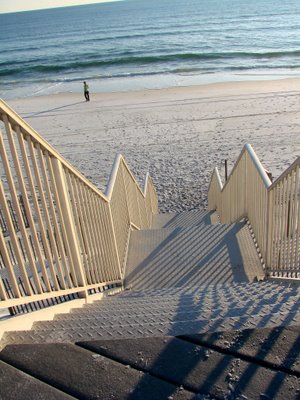
Stairs to the beach

A pristine beach awaits the visitor

A half-hour of beachcombing

Dunes

Dusk on the Gulf

Palmetto & sea oats silhouetted at sunset
For more information: http://www.floridastateparks.org/deerlake/default.cfm
Deer Lake is one of seventeen dune lakes located along the Gulf of Mexico in this vicinity that are extremely rare worldwide. For more information about these interesting and fragile lakes please refer to my earlier blog posting on Topsail Hill Preserve.
The forest here includes southern magnolia, scrub oak, long leaf pine and palmetto. Rare plants such as gulf coast lupine, spoonflower, pitcher plants, and Curtiss' sand grass form some of the largest populations found in Florida.
There are many species of resident or migratory birds and butterflies that utilize this fast disappearing mixed dune and coastal forest habitat, including the endangered least tern and loggerhead turtle. Other animals include bobcat, coyote, fox, raccoon, skunk, and a large assortment of reptiles and amphibians including alligators that inhabit Deer Lake. Park visitors can picnic, swim, and fish, but there is no camping as this is a day use area that closes at sundown.
I am very lucky, because I live right next door to this beautiful preserve and can visit it whenever I want. So by all means come on down and enjoy this perfect slice of the Florida panhandle. It is rarely crowded and always offers beauty, solitude and inspiration.
 Park woodland
Park woodland
Walkway across the dunes

Tracks in the dunes

Deer Lake

Stairs to the beach

A pristine beach awaits the visitor

A half-hour of beachcombing

Dunes

Dusk on the Gulf

Palmetto & sea oats silhouetted at sunset
For more information: http://www.floridastateparks.org/deerlake/default.cfm
Sunday, November 12, 2006
Camp Helen State Park
 Camp Helen State Park is a 184-acre preserve located at the far western end of Bay County along U.S. 98, just east of the Walton County line near Inlet Beach. Surrounded on three sides by picturesque bodies of water it is a forested peninsula filled with natural beauty and surprising diversity given its relatively small size. In one visit you can easily take in the beauty of white sand beaches fronting on the Gulf of Mexico, the marsh and bay environment of Phillips Inlet and the scenic shores of Lake Powell, one of Florida's largest freshwater dune lakes.
Camp Helen State Park is a 184-acre preserve located at the far western end of Bay County along U.S. 98, just east of the Walton County line near Inlet Beach. Surrounded on three sides by picturesque bodies of water it is a forested peninsula filled with natural beauty and surprising diversity given its relatively small size. In one visit you can easily take in the beauty of white sand beaches fronting on the Gulf of Mexico, the marsh and bay environment of Phillips Inlet and the scenic shores of Lake Powell, one of Florida's largest freshwater dune lakes.Rising above these lovely bodies of water is a beautifully forested maritime hammock that is chock full of live oak, long leaf pine and palmetto. The sugary white dunes encountered between this dense woodland and the Gulf shore are covered in the characteristic sand pine scrub community commonly found in this part of coastal Florida.

The primary forest cover consists of palmetto, live oak and longleaf pines.
Prehistoric middens and mounds indicate that humans lived on this neck of land more than 4,000 years ago. In the 1920's a wealthy family purchased the property that is presently the park and built a summer home overlooking Phillips Inlet. In 1945 the Avondale Mills of Alabama bought the property and operated it as resort for their employees until 1987. This "camp" was named Helen in honor of the CEO's daughter-in-law.
Activities include swimming, beachcombing, nature study, hiking, and both freshwater and saltwater fishing. This is one of my favorite Florida state parks because it is compact, scenic and diverse enough to keep me coming back to visit again and again. That I happen to live only a few miles down the road from this lovely preserve doesn't hurt either.
Activities include swimming, beachcombing, nature study, hiking, and both freshwater and saltwater fishing. This is one of my favorite Florida state parks because it is compact, scenic and diverse enough to keep me coming back to visit again and again. That I happen to live only a few miles down the road from this lovely preserve doesn't hurt either.

Beach along the shore of the Gulf of Mexico.

Pelicans perch on a storm wrecked pier.

Close-up of the perching pelicans.
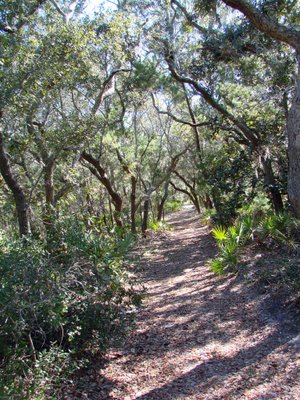
The main nature trail through the park.

Stairs leading down to Lake Powell

Lake Powell

Beach access trail

Beautiful tall live oaks are found throughout Camp Helen.
For more information: http://www.floridastateparks.org/camphelen/
Tuesday, November 07, 2006
Suwannee River State Park
Suwannee River State Park encompasses 1,800 acres in north-central Florida near the small town of Ellaville, adjacent to U.S. 90 and Interstate 10 (exit #275). Located at the junction of the Suwannee and Withlacoochee Rivers the park contains a wide variety of natural, cultural and historic features to interest the visitor. Set aside in 1936 it comemorates one of America's most romantic and storied rivers and is one of the oldest state parks in Florida.
Emanating from the depths of the Okefonokee Swamp in southeastern Georgia, the Suwannee River meanders for some 250 miles in a southwesterly direction into the Gulf of Mexico. According to researchers at the University of South Florida the name appears to be derived from the Timucuan Indian word Suwani which means "Echo River". Others say Suwannee means River of Reeds, Deep Water, or Crooked Black Water. Tannic acid from decaying palmetto roots and vegetation causes the blackness of the water.
The river became immortalized in song by Stephen Foster who penned the classic "Old Folks At Home" in 1851. Since 1935 it has been the official state song of Florida.
There are many trails in the park for the hiker to choose from. All have interpretive signs explaining the geology, ecological life zones and plants encountered along the way. One of the most scenic trails is Lime Sink Run, which parallels a creek that flows through craggy limestone outcrops and is dammed in places by beaver.

Cypress trees grace the banks of Lime Sink Run.
The Lime Sink Run Trail eventually connects with the Suwannee River Trail which hugs the bank of the river along a series of scenic high bluffs affording oustanding views of the river and dense hardwood hammocks floored with live oak, palmetto and cypress. Halfway along this track there are stairs leading down to Lime Spring. It rises up through the porous limestone of this area and empties directly into the river. Fed by the Floridian Aquifer it flows year-round.

Lime Spring gushes forth into the Suwannee River.

Lime Spring viewed from the trail on the bluff.

Lime Spring gushes forth into the Suwannee River.

Lime Spring viewed from the trail on the bluff.
There are interesting historical sites within the park that include the remnants of a former logging town (Columbus) and a plantation which hummed with activity when this part of Florida was connected to the outside world by paddle-wheeled steamboats which regularly plied the Suwannee between here and the Gulf of Mexico. The remains of the Columbus Cemetary is within the park boundaries and is believed to be one the oldest in the state. The Sandhills Trail, which leads to the cemetary, is a segment of the old stage road which linked Pensacola to Jacksonville and was constructed in the early 1800s.
Just south of the main ranger station, is an earthen embankment constructed by the Confederate Army during the Civil War to protect the railroad bridge that crosses the Suwannee at this point. Florida provided essential supplies to the Confederacy such as beef, salt, sugar and grain. These vital commodities were shipped via rail to Georgia on this main trunk line from the interior of the state. Union troops dispatched from Jacksonville to capture the bridge were repulsed near the town of Olustee in a bloody hard fought battle on February 20, 1864.
Just south of the main ranger station, is an earthen embankment constructed by the Confederate Army during the Civil War to protect the railroad bridge that crosses the Suwannee at this point. Florida provided essential supplies to the Confederacy such as beef, salt, sugar and grain. These vital commodities were shipped via rail to Georgia on this main trunk line from the interior of the state. Union troops dispatched from Jacksonville to capture the bridge were repulsed near the town of Olustee in a bloody hard fought battle on February 20, 1864.
There are also oppourtunities for fishing, canoeing and camping. Two picnic pavilions, a playground and nice modern cabins are available for those who don't want to rough it too hard in this rustic woodsy setting. This park is suited to visitors of all stripes and levels of intended exertion. All trails are for foot traffic only, vehicles and horses are not permitted.
Suwannee River State Park is a great place to experience the beauty of nature and the rich historical heritage of northern Florida. If you like it quiet and laid back than this is the place for you. Y'all come on down, ya heah?
Suwannee River State Park is a great place to experience the beauty of nature and the rich historical heritage of northern Florida. If you like it quiet and laid back than this is the place for you. Y'all come on down, ya heah?
Subscribe to:
Comments (Atom)

